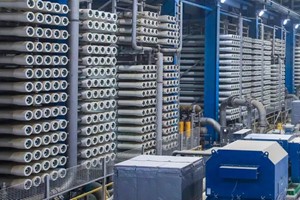Researchers at Oxford Brookes University have made significant strides in addressing a persistent global environmental issue: the contamination of water supplies with toxic chemicals known as per- and poly-fluoroalkyl substances (PFAS), often referred to as "forever chemicals." These chemicals have raised alarm due to their pervasive nature and potential health hazards, prompting a search for effective removal methods. The research team has developed a pioneering machine called a hydrodynamic reactor, which leverages the principles of cavitation— the formation and collapse of bubbles due to pressure changes—to effectively eliminate these harmful substances from water. Their findings have been published in the esteemed Chemical Engineering Journal.
PFAS chemicals, first synthesized in the 1930s, have been widely used in various consumer products such as waterproof clothing, nonstick cookware, pizza boxes, and stain-resistant carpets. However, their toxicity has been a cause for concern since the 1970s, and scientific confirmations of their dangers emerged in the early 2000s. Research has shown that these substances pose serious health risks, including links to ulcerative colitis, thyroid dysfunction, elevated cholesterol levels, liver damage, and even cancer. As a result, the need for effective methods to remove PFAS from water supplies has become increasingly urgent.
The challenges in addressing PFAS contamination stem from their widespread release into water bodies through multiple channels, including industrial wastewater, landfills with contaminated materials, domestic sewage, and agricultural runoff. As these pollutants infiltrate rivers, lakes, and seas, they ultimately make their way into public drinking water supplies, raising serious public health concerns.
Professor Iakovos Tzanakis, an expert in Engineering Materials at Oxford Brookes and one of the principal researchers, highlighted the significance of finding a sustainable and scalable solution for treating contaminated water. He stated, “Our challenge has been to find a way of effectively treating water to remove PFAS chemicals sustainably and at a scale.” In the UK, the Royal Society of Chemists has initiated a campaign aimed at reducing PFAS levels in water supplies, while the European Union plans to implement new regulations in 2024 to restrict the use of these chemicals. In the United States, legally enforceable limits on PFAS levels have also been established to safeguard public health.
Traditionally, methods for removing PFAS from water have been cumbersome, costly, and limited to laboratory settings, often relying on additional chemical treatments. However, Professor Tzanakis and his colleague Dr. Morteza Ghorbani, a Royal Society-Newton Fellow at Oxford Brookes, have identified a promising alternative. Their research has led to the collaboration with multiple institutions, including Sabanci University in Turkey, the white goods manufacturer Beko, KTH Royal Institute of Technology in Sweden, and the IVL Swedish Environmental Research Institute, to develop and test the hydrodynamic cavitation reactor.
This innovative reactor operates by utilizing fast-moving liquids within confined spaces to generate and collapse numerous tiny bubbles. This bubble activity aids in the cleaning process, enabling the effective breakdown of PFAS compounds. Professor Tzanakis remarked, “This technology has the potential to revolutionize wastewater treatment, making it safer and more sustainable for communities around the globe.” The advancements in green hydrodynamic cavitation present a scalable alternative to existing methods, effectively addressing the limitations of traditional techniques.
Recent tests conducted at the Hammarby Sjöstad wastewater treatment plant in Sweden yielded exceptional results, far exceeding initial expectations. The hydrodynamic cavitation reactor achieved an impressive degradation rate of nearly 36% for 11 common PFAS variants in just 30 minutes, all without requiring additional chemicals. Dr. Ghorbani expressed excitement over the results, stating, “We didn’t expect that level of PFAS processing in such a short space of time.” This success has opened up avenues for further research, with the team delving into the fundamental mechanisms of PFAS removal to optimize the process.
Looking ahead, the next phase of research involves scaling up the hydrodynamic reactor to handle larger volumes of wastewater containing PFAS. Plans are underway to treat up to 20 liters of PFAS-contaminated water, with the reactor already constructed for this purpose. Subsequent goals include expanding the treatment capacity to 200 liters in a wastewater treatment facility in Sweden. Dr. Ghorbani emphasized the importance of refining this technology to prepare it for real-world applications, particularly in alignment with the European Union's 2035 strategy, which mandates that all PFAS-containing waste be treated.














